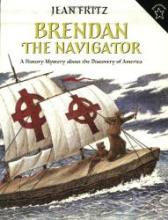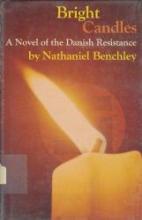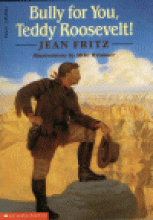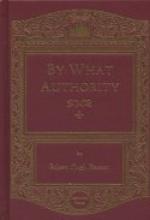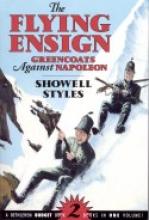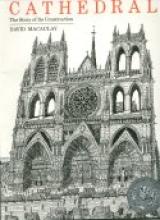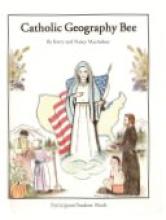History
Brendan the Navigator
Bright Candles
Bully for You, Teddy Roosevelt
By What Authority
It is early in the reign of Queen Elizabeth. Religion and politics are curiously mixed and confused. How will the people of England survive this tumultuous time and emerge as one of the great powers on the earth. This is the setting for By What Authority by Lord Robert Hugh Benson. It is the story of how two families, one Catholic and one Protestant, sort through the confusion and endure the suffering of finding and maintaining a religious identity.
The head of the Catholic family, Sir Nicholas Maxwell, is the Lord of a section in England just south of London. The Protestant family, Norris, lives next door and has a good rapport with the old Catholic family. The primarily Protestant village has great love for the Lord and his family and forgive them their superstitious religion. It is obvious that the younger Maxwell son is in love with Isabel Norris but the differences in their religions keep them apart – for a time.
Isabel Norris is a Jane Austen -type character, full of virtue and feminine moderation. She is happily Protestant and deeply devoted to her beloved Jesus. Her father, sensing the Maxwell youth's love for her, and worried lest the Maxwell ladies should convert her daughter to Catholicism, sends her to a friend in the country who is STRICTLY Puritan. His hope is that she will be repelled by the strictness and return to his middle-of-the-road Church of England Protestantism. Isabel is indeed horrified at the fiery God portrayed in the Puritan church but the movements of her heart and religious sentiments foreshadow her as a Catholic at heart. While she is away her father dies and when she returns, Lady Maxwell's sister becomes her living companion. This sister is actually a nun who was sent away from her convent and so begins the slow conversion of Isabel. Sir Benson is masterful at describing the mental and spiritual movements of a soul and so the reader is brought through all the agitation and wonder of Isabel discovering, discarding and finally accepting the truth about the Catholic Faith. In the midst of her struggles, young Hubert Maxwell has stated his intentions toward her and begs her to wait for him, claiming that the religious issue will resolve itself somehow. He leaves to sail off with Sir Francis Drake on one of his first piratical voyages. When he returns, ready to embrace her AND proud to announce his conversion to her Protestant faith, he finds that she has very nearly converted to Catholicism. He is furious and offers to be whatever religion she wants. In saying that, he has lost her. To her, the Faith is something so intrinsic that it cannot merely be put on and off as is convenient. She maintains her love for him through the whole story but she knows that she cannot be his wife.
All the while Isabel is suffering and coming into the Catholic Faith, her brother Anthony has graduated from Cambridge and, full of patriotism and religious fervor, sets out to set himself up in the world. He goes to work for the Archbishop of Canterbury and so is thrust into the politics and religion of the times. He has an occasion to meet and debate with a Catholic man and feels his Protestant beliefs disturbed. He also witnesses Edmund Campion's so-called trial and his execution and is very much affected by it. Sir Benson spends a lot of time describing the trial and relating the arguments made on both sides. During this trial, Anthony is basically converted. He sees that ALL the religious questions boil down to who has the authority to interpret the Bible and speak for Christ. Protestantism taken to its extreme would have each person interpreting the Bible as he would and becoming his own authority. That in itself did not fit with scripture, he thought. He realizes that the Church of Rome has the greatest claim to that authority. He submits his resignation to the Archbishop and attends an Ignatian Retreat with Father Robert Persons. At the end of the retreat he goes to tell his sister, Isabel that he has converted only to find her in the same situation. They come into the Church together to the great joy of the Maxwells (excepting Hubert).
Anthony becomes a priest at a seminary on the Continent and returns with Isabel to England at the time of the defeat of the Spanish Armada. He eventually is captured and threatened with torture and death. He meets with the Queen herself and she offers to let him leave the country alive yet have it let out that he signed "the oath" which says that he acknowledges the Church of England. He, of course, refuses and the enraged Queen sends him off to the torturers. He dies on Easter morning as Isabel kneels at his bedside reading the Gospel of the day. She has decided to leave England and perhaps enter religious life.
One of the most interesting aspects of the story is Benson's portrayal of Queen Elizabeth. She is fierce and unforgiving yet feminine and remorseful. He is very successful at describing the development of the awe in which her subjects hold her. She is awe inspiring. She is a formidable enemy and very moved by the loyalty of her people. She admires the gallantry and strength of the Catholic martyrs. She does not seem to be a deeply religious person herself and so cannot understand why these Catholics can't just accept things in order to live and have peace. He portrays her as having a certain goodness that is overshadowed by a multitude of forces, both within her and without.
The story would be excellent for upper high school level (and any interested adult). It might be interesting to read it along with a biography of St. Edmund Campion or Sir Francis Drake, and some history of the Spanish Armada. It is a compelling period in history and bears some deep thought as to its effect on today's world.
Byrd of the 95th
I really liked this book. I can vouch for my wife's statement that this is a great read aloud. I read it to my children at bedtime (ages 3 through 9) - they were engaged... though the younger ones usually fell asleep. The older two LOVED it.
Like the first book, there are plentiful descriptions of landscape, escapes, rescues, heroes, villians and architecture. The latter two are grouped for a reason. This book finds the ensign and all the principle characters of the last book together again. This time however, the story centers around a diversion to rescue the beautiful Anita and her noble father Don Claudio del Riego (one of the wealthiest noblemen in French-occupied Spain). They have been kidnapped, along with their hidden cache of jewels, by the traitorous El Cuchillo - a brigand from an ancient and once respected family - who makes his home in the family castle in the mountains. The castle features a knife-like spike of rock projecting up from within the fortress.
That the Spanish nobleman is now allied with the occupying French force, or that he chose to be a brigand rather than a noble may each be subjects for discussion of how the author gave him his nickname and abode - El Cuchillo - The Knife.
I had a hard time unraveling some of the battle scenes the author describes in the story until I got to the very helpful map on pg. 277. There's a lot of interesting military history, but I would have appreciated a few more maps.
It should also be noted that the author, while painting the valor and honor which the young ensign felt and aspired to, does not refrain from describing some of the gruesome aspects of battle. Unlike so many Disney stories (thank goodness) men actually die in this book. Children are neither idiots nor prudes in realizing the effect of violence can be death! You may want to read it to your kids - you can. But, for younger listeners, you may wish to keep an eye out for the few graphic descriptions. For instance: "In the ranks a few yards away gaps appeard - men flung into fragments by the flying [cannon] balls, men struck down and screaming in agony." Or in the story above: "... saw one twelve-pounder ball hurtle through the ranks a few paces from him, tearing two green-coated men into red fragments and ripping an arm from a third."
This is an enjoyable, readable story about a heroic young man who braves dangers and wins. In other words, a good hero story for kids. And the pretty young sable-haired Anita should be appealing to both boys and girls as a person who knows courage as well as courtliness.
This book was donated for review by Bethlehem Books.
Cathedral: The Story of Its Construction
Catholic Cardlinks: Patron Saints
Children will love (I speak from experience with my own brood) to befriend the saints with this charming resource that they can so easily hold in their little hands. Each elongated cardstock sheet has a colorful sketch of a saint (48 saints in all) with a short biography. The pages fan out so that you can see all of the faces at once. Or open to one at a time and spend a little time reading about your favorites. When I leave this sort of book laying in reach of my little ones (especially the pre-readers), they will become acquainted with the pictures over time and find their favorites that they ask me to read about over and over. What a nice way to help young children develop a devotion to a favorite saint!
I'm also delighted to see such colorful and creative resources being published for young children.
Binding details: cardstock pages pivot on a sturdy post
Catholic Children's Treasure Box Books 1-6, story of St. Therese
Catholic Geography Bee
The Participant/Student Book (softcover - stapled), is a study book for learning facts and figures in preparation for a Geography Bee. Three summary charts provide a quick reference on Name Derivations, Famous Natives, Mottos , Landmarks, Catholic Facts, Historical Facts, Industry, Admission Dates, Capitals, Flowers, Birds, Nicknames and Trees for each state. The bulk of the text consists of Study Sheets on: Capitals, State Flowers, State Birds, Nicknames, State Trees, Famous Natives, Landmarks, Catholic Facts, Historical Facts, Name Derivations, Mottos and Industry. In addition to a simple chart for each category, the Study Sheets provide a "To Learn More" segment which provides detailed information about each item. For example, the State Flower section includes a description of each type of flower and the Famous Natives section provides a brief biography of a famous native from each state as well as an extensive list of other famous natives. Of special interest is the "State Catholic Fact" section which provides Catholic connections for each State and which should provide a starting point for studying more about Catholic influences in the United States. The last half of the book offers various worksheets and other masters to photocopy - State Profile (can be used to record or test information for each state), State Flowers to color and learn, State Birds to color and learn, simple outline maps of each state, and a full outline map of the whole United States. Also are included are a partial listing of Catholic-named Cities of the U.S., a Bibliography, Sources for Further Study and Internet Sites for Further Study.
The Coordinator/Parent Book offers master category cards and a certificate of honor to copy and color for an official-looking Geography Bee, a spreadsheet of basic facts, and extensive sets of questions on three different difficulty levels for each category of study in the Participant Book (State Capital, State Flower, State Bird, State Nickname, State Tree, State Landmark, Famous Natives, and State Catholic Fact). The third difficulty level also offers questions regarding State Historical Facts. Because questions for each category are listed separately (rather than being intermixed), families could choose to focus on just a few category or difficulty levels at a time if they wish. Each question in this book provides the answer directly after the question in boldface type for ease of use.
I'm very, very impressed with the scope and quality of this Geography program. In the past, Catholic Homeschoolers have had limited resources available for State History and Geography (particularly from a Catholic perspective). These materials provide a welcome solution to this need as well as a wonderful project to be undertaken by a Catholic homeschool group or just a few families getting together. Highly recommended.

